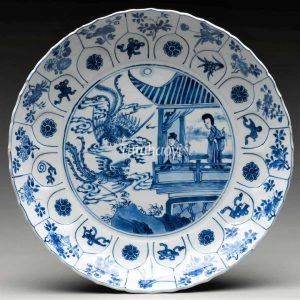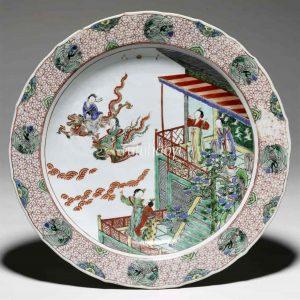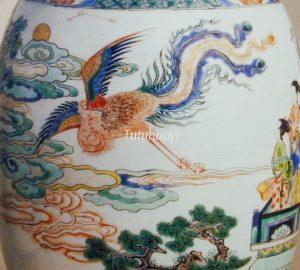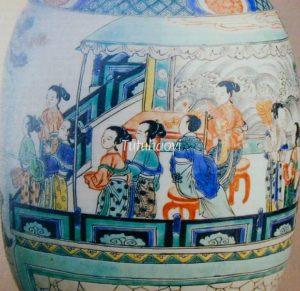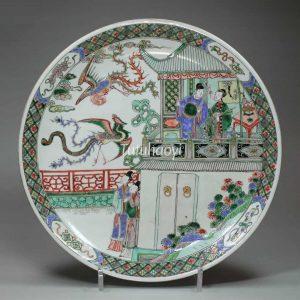Xiao Shi’s Playing the Xiao Flute Attracting Phoenixes
萧史吹箫引凤
© Tutuhaoyi.com owns the copyright of the description content for the images attached. Quoting all or part of the description content on this page is permitted ONLY IF ‘Tutuhaoyi.com’ is clearly acknowledged anywhere your quote is produced unless stated otherwise. (本页描述内容版权归Tutuhaoyi.com所有,转发或引用需注明 “Tutuhaoyi.com”, 侵权必究, 已注开源信息的条目除外。)
Duke Mu of the Qin State (秦穆公, died 621 BCE) was one of the so-called Five Hegemons (五霸 wuba) in the Spring and Autumn Period (770 – 476 BCE) (春秋 chunqiu). He had a daughter named ‘Nongyu (弄玉, meaning Playing Jade)’, who was a talented musician excelling at playing the sheng (笙 mouthorgan). Nongyu only wanted to marry her musical match so a recluse genius xiao (箫 flute) player, Xiao Shi (萧史), was discovered and brought to the duke.
The duke was not keen on Xiao Shi at first when he learned that the young man’s musical instrument was different from his daughter’s. However, Nongyu, who was sitting behind the screen listening to the audience, asked Xiao Shi to play a piece on his flute. Xiao did.
As soon as the first piece ended, a gust of fresh air blew in. When the tune resumed, gold-laced rosy clouds gathered from the four directions in the sky. During the third performance, a couple of white cranes danced in front of the duke’s terrace and peacocks flew in! Experiencing the magic spectacle, the duke was pleasantly amazed and his daughter cried with joy, ‘This is my man!’ It happened to be the fifteenth day of the eighth month of the traditional calendar and was supposed to be the lucky day of their marriage. They had their wedding on that very night.
The couple lived happily together for years while Xiao Shi taught his wife to imitate the singing of phoenixes on her musical instrument. Whenever they played together on the high pavilion terrace named ‘Phoenix Terrace’ specially built for them, phoenixes would flock around them. One day, the couple rode on the divine birds ascending to heaven.
The story scene depicted on the Kangxi plate in the collection of the British Museum and on the Kangxi vase in the collection of Metropolitan Museum of Art, NY was first deciphered by Dr Yibin Ni. More detailed discussion as well as parody of this scene is available here.
Fig 1: porcelain dish with underglaze blue decoration, Kangxi period (1662-1722), courtesy of the Metropolitan Museum of Art, New York
Fig 2: porcelain dish with overglaze enamelled decoration, Kangxi period (1662-1722), courtesy of the Trustees of the British Museum
Fig 3-4: porcelain vase with overglaze enamelled decoration, Kangxi period (1662-1722), courtesy of the Metropolitan Museum of Art, New York
Fig 5-7: porcelain lantern with overglaze enamelled decoration, Kangxi period (1662-1722), courtesy of Anthony de Rothschild
Fig 8: porcelain dish with overglaze enamelled decoration, Kangxi period (1662-1722), courtesy of previous Guest and Gray collection, London, ref: Y687
Fig 9-10: hanging scroll with silk embroidery, Kangxi period (1662-1722), Qing dynasty, courtesy of Palace Museum, Beijing
Fig 11: brick carving, Qing dynasty (1644-1911), courtesy of Anhui Museum, China
